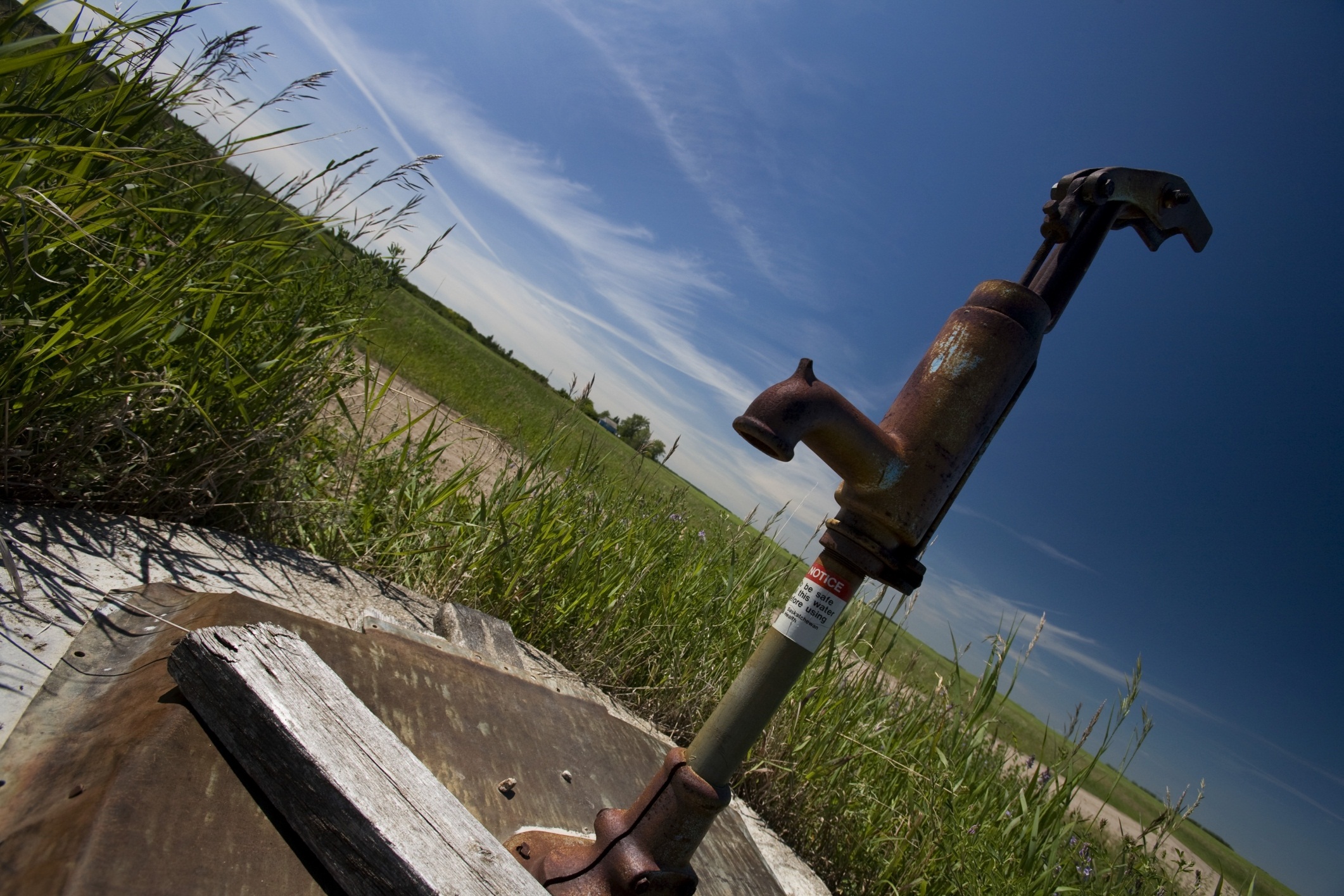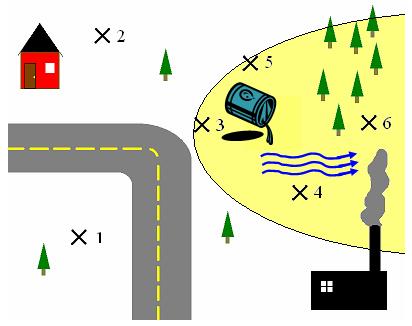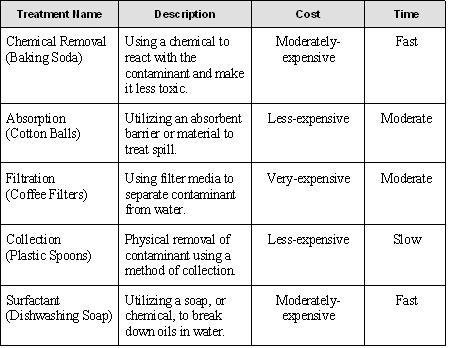Groundwater Pollution Detectives
Teachengineering.org activity was contributed by the College of Engineering’s Integrated Teaching and Learning Program at the University of Colorado, Boulder. It is part of a larger environmental engineering and earth science lesson on water.
Summary
Teams of students in grades 5 to 7 locate a contaminant spill in a hypothetical site by measuring the pH of soil samples. They then predict the direction of groundwater flow using mathematical modeling and use the engineering design process to come up with alternative treatments for the contaminated water.
Grade Level: 5-7
Time: 90 minutes
Learning outcomes
After doing this activity, students should be able to:
- Explain that engineers use mathematical modeling to make predictions about a design problem.
- Describe how engineers take water samples and analyze data to determine where groundwater contaminants come from and where they are going.
- Identify several methods for cleanup of contaminated groundwater used by engineers.
Standards
Next Generation Science Standards
- Define the criteria and constraints of a design problem with sufficient precision to ensure a successful solution, taking into account relevant scientific principles and potential impacts on people and the natural environment that may limit possible solutions. [Grades 6 – 8]
- Science & Engineering Practice: Define a design problem that can be solved through the development of an object, tool, process or system and includes multiple criteria and constraints, including scientific knowledge that may limit possible solutions.
Common Core State Mathematical Standards
- Number System 6.NS.B2. Fluently divide multi-digit numbers using the standard algorithm. [Grade 6]
- Number System 6.NS.B3. Fluently add, subtract, multiply, and divide multi-digit decimals using the standard algorithm for each operation. [Grade 6]
- Expressions & Equations 6.EE.B7. Solve real-world and mathematical problems by writing and solving equations of the form x + p = q and px = q for cases in which p, q and x are all nonnegative rational numbers. [Grade 6]
- Geometry 7.G.A1. Solve problems involving scale drawings of geometric figures, including computing actual lengths and areas from a scale drawing and reproducing a scale drawing at a different scale. [Grade 7]
Next Generation Science Standards
- Define the criteria and constraints of a design problem with sufficient precision to ensure a successful solution, taking into account relevant scientific principles and potential impacts on people and the natural environment that may limit possible solutions. [Grades 6 – 8]
International Technology and Engineering Educators Association
- Standard 4. Students will develop an understanding of the cultural, social, economic, and political effects of technology. [Grades K – 12]
- E. Technologies can be used to repair damage caused by natural disasters and to break down waste from the use of various products and systems. [Grades 6 – 8]
Engineering Connection
Introduction/Motivation
- Containment with physical barriers, or putting something in the ground to stop the groundwater flow.
- Biological treatment, by adding microorganisms like bacteria that break down, or “eat,” the pollution to make it less toxic.
- Chemical treatment, by adding chemicals like chlorine or ozone that react with the contaminant to make it less toxic.
- Soil vapor extraction, by moving air and vapors through the groundwater in order to remove the contaminant.
- Constructed wetlands, where several treatment methods are used in a shallow pond-like area.
- Pump and treat methods, where engineers pump the contaminated water out of the ground, treat the water and put it back into the ground.
Materials
Each group should have:
- 6 strips of wide-range pH paper (litmus paper) Note: 100 strips are available for less than $5 at many chemical supply companies, such as Auspex Scientific
- 7 numbered small plastic cups for samples
- Plastic spoon for mixing
- 2 copies of the Finding Pollution Worksheet
- 12-inch ruler
For the class to share:
- 6 Ziploc® bags or plastic bins
- ~12 cups of playground sand
- 1 marker or Sharpie®
- 1 roll of masking tape
- 6 teaspoons
- 1 container of unsweetened powdered lemonade mix
- 6 soil samples (made from sand and lemonade mix; see Procedure section for preparation instructions)
- jug of water
- 1 bottle of vegetable oil
- 1 box of baking soda
- 1 bag of (any-sized) cotton balls
- 6-10 coffee filters (any size, kind)
- 6-10 plastic spoons
- 1 bottle of liquid dishwashing soap (any kind)
- (optional) plastic disposable gloves
Procedure
Before the Activity
- Using a marker and masking tape, label the six Ziploc® bags (or plastic bins) with the numbers 1-6.
- Create six bags of equal amounts of sand (about 2 cups each) using Ziploc® bags or plastic bins. These are your soil samples.
- Mix the soil samples in the appropriately-numbered bags/containers with different concentrations of lemonade according to the map in Figure 1 (the highest concentrations of lemonade should be the numbers located in the yellow oval of the map). Samples 1 and 2 should have no lemonade, sample 3 should have the highest concentration of lemonade, sample 6 should have the lowest concentration and samples 4 and 5 should be equal concentration higher then sample 6 but lower then sample 3.
-
- Make the highest and lowest concentration samples, and then test the pH to make sure they are indeed different and in the range of the pH paper.
- Make a copy of the Groundwater Pollution Worksheet for each student.
- Set up a supply station in the classroom. The station should have the six samples clearly labeled, a teaspoon and a water source for Part I. This station can also have all of the treatment methods for Part II. Alternatively, this can be done at lab stations and each station can have all six samples.
- Next, make a batch of polluted water for Part II by mixing water, lemonade and vegetable oil. Test the water sample to make sure that the pH of the water sample matches the pH of the #3 Soil Sample. (Note: You can also add dirt, cocoa or food coloring to make the sample “muddy.”)
With the Students
Part I – Finding the Contaminant Spill- Explain to the students that they are professional environmental engineers and have been asked by the state to detect and treat a contaminant plume. Here is the situation (note: provide the students with as much or as little detail you feel necessary):
A French chemical company created a chemical called Le Chimique. Le Chimique is a highly toxic, highly acidic cleaning agent, which became illegal to use in 1990. The company is now bankrupt, and the government wanted to redevelop the land; however, when they started digging, traces of highly acidic Le Chimique were found in the soil. They did some research and found that there was a spill, but they did not know where or when it occurred. The local community heard about the newly discovered spill and is worried that it might affect their water supply. In response, the government has taken several samples of soil in the area over the course of the year. They have hired you to test the samples and find where the spill occurred, predict in what direction the groundwater is moving, and how fast, so they can best determine how to clean up the spill. They have taken six soil samples from the groundwater and then dried them to make transport easier.- Pass out the Finding Pollution Worksheets, 7 cups, pH (litmus) paper and a plastic teaspoon to each student group. Show students where the six soil samples are located.
- Have students label 6 of the cups #1 – #6. Label the 7th cup “water.”
- Explain to students what pH is and how to use pH paper. Explain concentration. It is helpful to remind students that the contaminant they are looking for is highly acidic. In other words, if the sample has a low pH, then it will be highly acidic, and they can conclude that there is a high concentration of Le Chimique in that sample.
- Explain and demonstrate the following procedure to the students.
- Students should take the water cup, plastic soon and two other cups to the samples station. Have the students fill the water cup with water and the two numbered cups with one teaspoon of the corresponding soil sample. For example, put a teaspoon of Sample 1 in cup #1, Sample 2 in cup #2.
- Then, have students return to their seats and add two spoonfuls of water to each sample. They should mix it up and then test it with the pH paper. Have students record the pH of each sample in the first column of their worksheets. Students should repeat this process until they have tested all of their samples.
- After students have measured all the samples, have them fill out the second column of their worksheet with relative concentrations of the contaminant in the sample. Samples that have a high pH have low acidity and a low concentration of Le Chimique. Samples that have a low pH are highly acidic and have a high concentration of Le Chimique.
- Finally, students should put a star on their maps showing where they thought the spill occurred, an arrow indicating direction of groundwater flow and a rough outline of what they think the plume looks like. (This should become apparent with the varying levels of pH.)
- Finally, have the students determine the velocity (v) and flow rate (Q) of the plume, using the distances and times provided on the Groundwater Pollution Worksheet. The students should use this information to predict when the flow will reach the community at point A.
Part II – Remediation of the Contaminated Groundwater- Now that the students have determined when the contaminant spill might reach community A, they will work on treating the spill. Explain to the students that the state has selected a “pump and treat” method of cleaning up the groundwater based on the recommendations of your engineering firm. They have hired your class to remove the contaminated water at the source of the spill and propose methods for cleaning the water before placing it back into the ground. While removing a sample of the contaminated groundwater to test, it was discovered that oil used in the packaging of Le Chimique was also found in the sample. Le Chimique is highly toxic, and special care will need to be taken for cleaning up the water. At the same time, the state has a tight budget for remediation of this site.
- Show students the water sample taken from the source of the spill. Next, show them (hold up for display) the different “tools” (treatment type, as described in the table below) available for removal.
- On their worksheet, have students brainstorm combinations of treatment methods that might clean up the contaminated groundwater.
- Next, have students show the teacher their ideas. Have them obtain a small sample of the contaminated water in one of their plastic cups from Part I.
- The students may try their methods of clean up while following along with the worksheet. If time and material permit, allow the students to improve on their ideas with another sample of contaminated water.
- Lastly, have the students discuss as a class what worked well and why. Have the students also discuss the possible cost and environmental effects of the treatment methods they chose.
Safety Issues
- Although made from a lemonade mix, students should not eat or drink the samples.
- Students should wear safety goggles.
- Avoid using latex disposable gloves for Part II of the activity, as some students may have a latex allergy.
Troubleshooting Tips
The inverse relationship between pH and acidity can be confusing. It may be helpful to write the following on the board for reference:Low pH = High acidity = High concentration of Le ChimiqueHigh pH = Low acidity = Low concentration of Le ChimiqueWatch National Geographic feature on innovative technology to tackle California’s groundwater drought:
Assessment
Pre-Activity Assessment
Concept Review: Review groundwater flow with students. Ask students the following questions to review their previous knowledge of groundwater flow.- What is an aquifer? (Answer: An aquifer is water under the ground that technically provides a useable amount of water when pumped.)
- Why do engineers and many people care about groundwater? (Answer: because many people get their drinking water from the groundwater)
- If a can of oil was spilled on the ground by the school, could it end up in the town well 5 miles south of the school? (Answer: Yes, the oil will infiltrate through the ground and then travel with the groundwater in the direction of groundwater flow. The oil will not end up in the town well, however if the groundwater dose not flow south.)
Activity Embedded Assessment
Groundwater Pollution Worksheet: Have the students record pH measurements, and follow along with the activity on their Groundwater Pollution Worksheet.Class Discussion of Treatment Methods: Discuss with students the remediation choices listed on their worksheets and why they chose the ones they did (#10). There are many advantages and disadvantages to each treatment option, including cost, time and environmental effects. Ask students which efforts might have the biggest impact on the environment of those listed. (Answer: Chemical treatment and physical barriers.)Post-Activity Assessment
Class Discussion of Pollutant Transport: Show students an overhead transparency of the site map or sketch the site map on a white/chalk board. Ask a student from each group to draw where s/he thinks the plume is located on the map. Once all the data is on the board, discus the results through the following questions.- Did all the groups get the same exact answer? (Answers may vary.)
- If no, why not? (Answers will vary)
- Do you think this happens in the real world? (Answer: Yes, scientific data is highly variable and sometime yields different answers – especially in the environmental engineering field. The case the students looked at is very real. Most of the time when pollution has been detected, no one knows when or where it originated, or sometimes, they do not even know what was spilled. Environmental engineers are charged with cleaning up spills without much knowledge of what is under the ground.)
- Often, contaminant plumes spread out in all directions. Why might our plume spread faster in one direction than the other? (Answer: The plume spreads in the direction of the groundwater movement. There is probably a hill or higher elevations on the left side of the map.) Another reason might include the type of soil/substrate — such as high concentrations of clay on the left side of the map.
Class Discussion of Groundwater Remediation: Have students discuss the treatment process that their team developed. Did it work? Why or why not? What would they do to improve their treatment method? (Answers will vary.) Discuss with students how engineers often iterate several different designs when developing a final process or product. In this case, environmental engineers may have to test several different methods of treatment to find one that works with both the highly acidic Le Chimique and the associated oil products. Engineers also often have to design within constraints, such as limited budget (cost) and environmental effects of the treatment process.Activity Extensions
Have students research possible environmental effects of contaminant spills and report back to the class.Have students complete a cost analysis of their design by assigning relative dollar amounts to the treatment components. A cost for the time to complete the treatment methods can also be included.Have students develop a report for community A that explains the mathematical modeling and predictions of when the contaminant would have reached the houses. Then, have the students report on what remediation techniques were used and the results of those techniques.Watch the movie “A Civil Action” (1998, with John Travolta and Robert Duvall), and have students compare and contrast the movie with what they did in the activity. They can either write a short essay or in a chart, write two things that were the same and two things that were different.Activity Scaling
For lower grades, make new keys for the pH paper that do not just have numbers for pH, but also high, medium and low acidity and high, medium and low concentration. Also, it may help to work through the mathematical modeling as a class or eliminate this part completely.Additional Resorces
Groundwater Basics. All about aquifers and their use from the U.S. Geological Survey’s Water Science Schools. See also the USGS’s groundwater-level tables.
Ground Water. The U.S. Environmental Protection Agency’s site includes a Citizen’s Guide to Groundwater Protection (pdf) and classroom activities such a build your own aquifer.
The Global Water Sampling Project. Join students from around the world collecting data on water quality or contribute information to the World Water Monitoring Challenge.
How’s My Waterway? Learn the condition of local lakes and streams anywhere in the country on the U.S. Environmental Protection Agency’s searchable registry.
What is Groundwater? University of Nebraska, Lincoln animation explaining where water comes from.
Contributors
Ben Heavner, Malinda Schaefer Zarske, Janet Yowell, Melissa Straten
© 2005 by Regents of the University of Colorado
Filed under: Class Activities, Grades 6-8, Grades 6-8, Grades K-5, Grades K-5, Lesson Plans
Tags: aquifer, Class Activities, clean drinking water, Environmental Engineering, Environmental science, groundwater, Pollution, Water Resources











